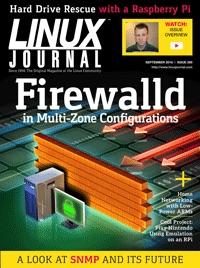Linux Journal September 2016


Doing Old Things in New Ways
Our new house is built into the side of a hill. It's not quite a Hobbit hole, and our doors are rectangular as opposed to round, but it still has its challenges. The first challenge we face is mowing the front yard. There's an approximate 15' drop over the 20' from the house to the road. The safety concerns aside (mowing side to side is dangerous and really difficult, and mowing downhill is asking to get your toes cut off), with such a steep angle I couldn't keep the mower running! I went through several "solutions" before I found one that works. I bought a big weed whacker, thinking I'd mow the lawn that way. Then I bought a plug-in model electric mower, which somehow tries to eat its own cord at every turn. The final solution was a battery-operated mower. It works great, and the batteries are shockingly long-lasting. Ten years ago, the thought of a battery-powered lawn mower would have been ridiculous. As technology advances, the impossible becomes the practical. So, I say this fairly often: "It's so awesome to live in the future!"
Dave Taylor starts off the issue this month by traveling to Mars. Well, that's not entirely accurate. He starts off on the process of coding a text-based game simulating the landing procedure for a spacecraft on the surface of Mars. If you've ever played Lunar Lander and wanted to test the math, Dave's column will be right up your alley.
Most of us have a pile of servers somewhere in the house or garage that we use for experiments and to store our files. Kyle Rankin's server is in his garage (I'm jealous, I don't have a garage), and he recently decided it was time to upgrade. Rather than buying a huge server, however, Kyle decided to create a powerful NAS device using the smallest and most power-efficient server possible. This month he walks through his process and explains how he landed on the final solution. It's tinier and far more efficient than anything available just a few years ago. If you want to revamp your server closet or save some electricity by replacing old power hogs, check out his column.
I decided I wanted to do old things in new ways, but the things I wanted to do were all game-related. I spent a shameful number of weekends in my youth playing Nintendo games. Although Nintendo is releasing a console this winter with some classic NES games embedded into the system, there's something special about playing with the original controllers. This month I turned a Raspberry Pi and a cigar box into an emulation machine for Nintendo and Super Nintendo. If you ever played Super Mario Brothers 3 or had fever dreams about building experience points by killing Slime Molds, come play along.
We have a guest columnist this issue talking about SNMP. Andrew Kirch explains SNMP in simple terms and shares his frustrations over the lack of development it's gotten during the past decade. SNMP is more than just a way to read network data and build throughput charts. It's a two-way protocol that allows for actual management of devices. For a look at how SNMP works and why we should be giving it more attention, be sure to read Andrew's column!
Nathan R. Vance and William F. Polik teach how to build a wall. Specifically, they describe how to use firewalld in multi-zone configurations. Firewalld makes building firewall rules much easier, and that clarity allows for more complex sets of rules that still make sense. Nathan and William take the daunting concept of firewall zones and make it easy to understand. They're followed by another Andrew, Andrew Nii Addo, who gives us a lesson on rescuing hard drives with a Raspberry Pi. For years I kept a full-blown tower on my workbench for the inevitable hard drive rescue operations. With Andrew's guidance, you can use a simple Raspberry Pi to do the same task in a far more convenient way.
The Linux kernel itself was created to do something old in a new way. In fact, pretty much everything we do with technology is designed to do old tasks in more efficient ways. Sometimes it's important to stick with tried and true methods. So we've also included the usual tech tips, product announcements and technology tidbits you've come to expect from every issue of Linux Journal. I learned a lot this month, and as a reward, I plan to play Nintendo. Maybe not as long as I did in high school, but I think there are still a few Slime Molds left in the forest who need to taste my sword!
Available to Subscribers: September 1










